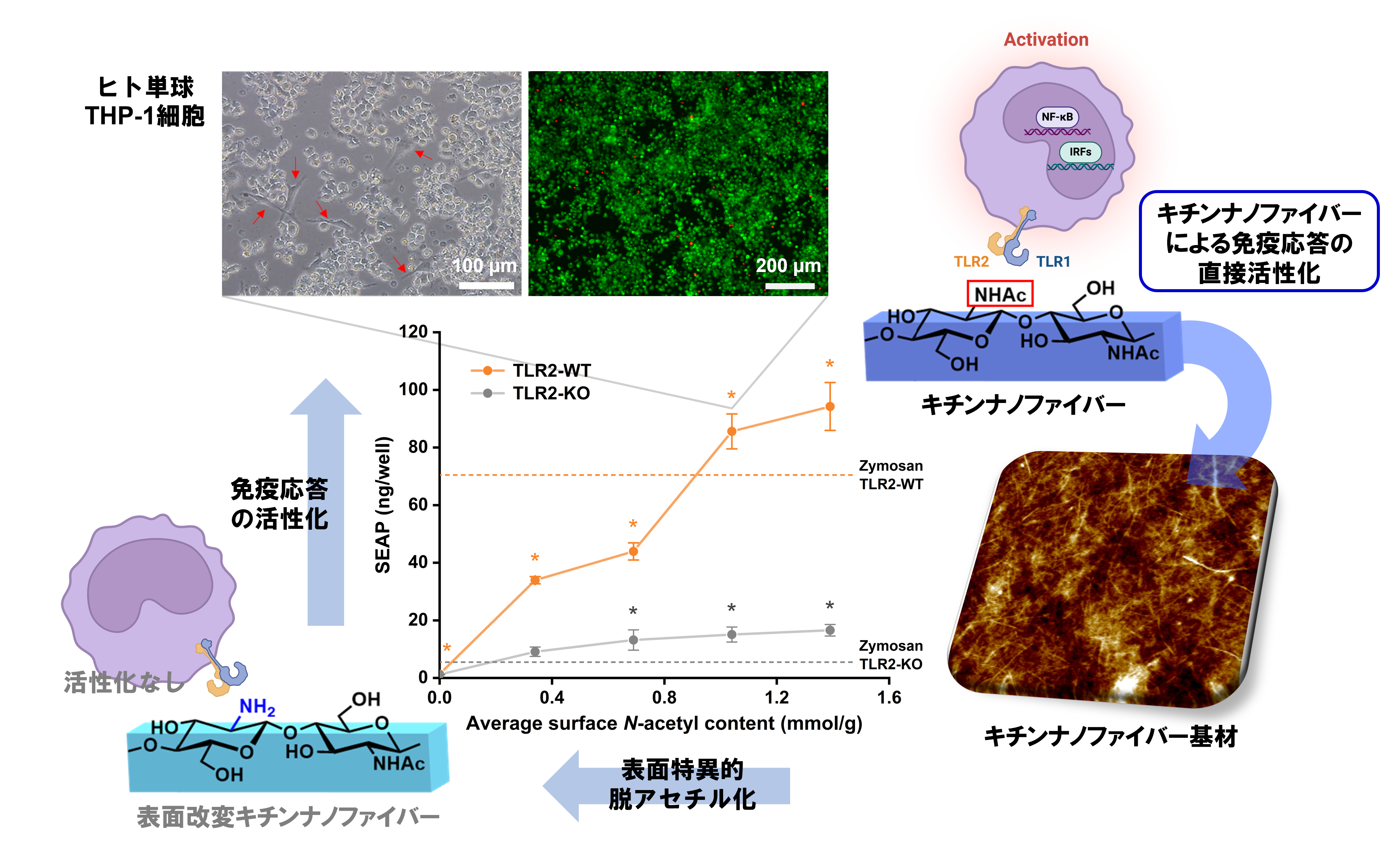Prof. KITAOKA and his research group have successfully achieved the direct activation of human immune cells by controlling the interfacial structures of crab nanofibers.
Natural polysaccharide nanofiber technology opens new avenue for biomedical modalities with safety and reliability
POINT
- The effects of vaccines and immunotherapy vary widely from person to person, and the use of immune stimulants (hereafter referred to as adjuvants) is essential.
- We have successfully discovered that chitin nanofibers *1 can directly activate immune cells via human innate immune receptors.
- It is expected to be a new medical modality as an agonist *2 that enhances the efficacy of immunological drugs by controlling the interfacial structures of natural polysaccharide nanofibers.
SUMMARY
Adjuvants that activate natural immunity have the effect of enhancing the efficacy of vaccines and cancer immunotherapy, and are expected to improve individual differences in efficacy, reduce the amount of antigen contained in vaccines and the number of vaccinations, and enhance the efficacy of drugs for newborns and the elderly with weak immune systems. However, the number of adjuvants approved in Japan is limited to aluminum salts (alum) and oil emulsions.
At the beginning of this century, it was discovered that Toll-like receptors (TLRs) on the surface of animal cells detect various pathogens and control innate immunity, and in recent years, much attention has been paid to TLR-activating adjuvants that exploit this mechanism, and there is growing anticipation for the development of safe and effective TLR-activating drugs like agonists.
Ms. HATASE Risa (second year master's student at the Graduate School of Bioresource and Bioenvironmental Sciences, Kyushu University), Dr. Qi Li (research assistant professor), Assistant Professor Dr. HATAKEYAMA Mayumi, and Professor Dr. KITAOKA Takuya at the Faculty of Agriculture, Kyushu University, have successfully discovered the controlled culture of TLR2-expressing HEK293 cells and human monocytes on a substrate of crab-derived chitin nanofibers, in which the polysaccharide nanofibers can directly activate the TLR2 receptor signaling. Furthermore, by precise deacetylation of the surface of chitin nanofibers, they successfully created polysaccharide scaffolds with different surface carbohydrate structures and also discovered a mechanism for controlling human immune responses that depends on the amount of N-acetylglucosamine on the substrate surface.
This discovery is expected to lead to the development of new adjuvants and new medical modalities that use the TLR activation mechanism to interact between safe natural polysaccharides and human immune cells.
The research was published in Elsevier's journal International Journal of Biological Macromolecules on Sunday, December 1, 2024 (Japan time).
Comment from the Researcher

This research has discovered that chitin nanofibers, which can be obtained from the edible waste (hard shells) of delicious crabs, can directly activate the receptor proteins of the human innate immune systems. I am excited about the future development of this research, as I believe that common natural polysaccharides can be used as pharmaceuticals in the near future to benefit our health and One Health. (HATASE Risa, 2nd year master's student)
GLOSSARY
*1 Chitin nanofiber
Natural nanofiber materials derived from structural polysaccharides found in crabs and shrimps, produced by down-sizing bulk polysaccharides to the nanometer scale (a nanometer is one-billionth of a meter).
*2 Agonist
A substance that binds to receptor proteins on the cell surface and is involved in inter- and intracellular communication (e.g., immune response).
Paper Information
Journal: International Journal of Biological Macromolecules
Title: Direct activation of Toll-like receptor 2 signaling stimulated by contact with the interfacial structures of chitin nanofibers
Authors: Risa Hatase, Qi Li, Mayumi Hatakeyama, Takuya Kitaoka
DOI: 10.1016/j.ijbiomac.2024.138092
Research-related inquiries












 Contact
Contact
 Access Map
Access Map

